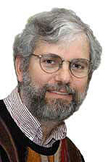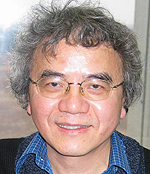| Research
|
From the event display that enabled researchers to see the very first collisions at the CDF detector, to the earliest top quark data, to Fermilab's leadership in large scale computing using Linux, G.P. Yeh has made many contributions during his twenty years at DOE's Fermilab. Lately he has been working on a project of a different scope. When Japan 's Minister of Science and Technology Policy, Koji Omi, announced in 2001 a plan to create the Okinawa Institute of Science and Technology (OIST), the Minister appointed Yeh as a Special Advisor for the project. Yeh had already been bringing graduate students from Okinawa to do research at Fermilab. "The main goal of OIST is to establish one of the best graduate universities in the world," Yeh says. "This project has incredible, strong support from the leaders of Japan , the scientific community worldwide, and every one of the 1.3 million people of Okinawa." Fourteen Nobel Laureates, including Jerome Friedman of MIT and Leon Lederman of Fermilab, have been supporting the project as well. Since then, the Japanese government has annually increased the project's budget, and in 2003, the Okinawa government donated 700 acres of land. Organizers published the master plan for the school in January 2006, and construction is scheduled to begin this spring. The university plans to have 300 professors, 500 graduate students, and 900 postdoctoral researchers. "They say on Okinawa, 'This is a once in a hundred years chance for us. Please succeed,'" Yeh says. Yeh joined Fermilab in March 1985 and recalls that his first task was to write an event display enabling CDF researchers to view the collisions made by the Tevatron's proton and antiproton beams. He served as a member of the International Organizing Committee for worldwide studies for the International Linear Collider from 1998 to 2003 and remains active in many international scientific organizations. Yeh declares: "Why do I say Fermilab is paradise? Here we have scientists and students from 200 universities, from about 40 countries. It's so nice every day in the cafeteria, hallways, anywhere—you can talk to people from all different backgrounds." Submitted by DOE's Fermi National Accelerator Laboratory |
|||||||||||||||||||||||
|
Check out symmetry—the
|
Bucksbaum propels
|
 |
Phil Bucksbaum |
PULSE is a partnership between Stanford and the DOE to provide a central home and world leadership in ultrafast and short wavelength science and technology. Ultrafast science examines the fast movements and transformations of atoms, molecules and materials that take place in mere femtoseconds (quadrillionths of a second). The center's researchers will develop groundbreaking experiments and exceptional machine capabilities for an incredible new tool for ultrafast x-ray science—the Linac Coherent Light Source (LCLS)—currently under construction at SLAC.
PULSE's research programs include atomic-molecular-optical physics, time-resolved x-ray scattering, ultrafast magnetic effects, single molecule imaging, ultrafast chemistry, ultrafast electron beam physics.
"We're having wonderful new results in these areas," he said.
Bucksbaum's own research involves quantum control. In his new lab in the Varian physics building at Stanford he is building an ultrafast laser that emits 5.2 femtosecond pulses of optical light —"about as good as it gets," he notes. Using precise control over the energy and timing of the laser field, researchers will rip an electron off an atom in larger molecule and then send the electron careening back into the molecule to get an image of chemical changes as they take place in the molecule.
"It will be control of quantum mechanics at a real virtuoso level, and will help us in developing the imaging we want to do with LCLS," he said.
Submitted by DOE's Stanford Linear Accelerator Center


